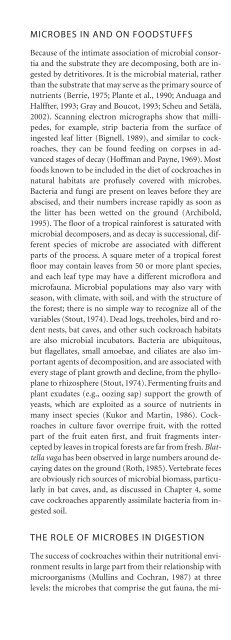Cockroache; Ecology, behavior & history - W.J. Bell
Cockroache; Ecology, behavior & history - W.J. Bell
Cockroache; Ecology, behavior & history - W.J. Bell
You also want an ePaper? Increase the reach of your titles
YUMPU automatically turns print PDFs into web optimized ePapers that Google loves.
MICROBES IN AND ON FOODSTUFFS<br />
Because of the intimate association of microbial consortia<br />
and the substrate they are decomposing, both are ingested<br />
by detritivores. It is the microbial material, rather<br />
than the substrate that may serve as the primary source of<br />
nutrients (Berrie, 1975; Plante et al., 1990; Anduaga and<br />
Halffter, 1993; Gray and Boucot, 1993; Scheu and Setälä,<br />
2002). Scanning electron micrographs show that millipedes,<br />
for example, strip bacteria from the surface of<br />
ingested leaf litter (Bignell, 1989), and similar to cockroaches,<br />
they can be found feeding on corpses in advanced<br />
stages of decay (Hoffman and Payne, 1969). Most<br />
foods known to be included in the diet of cockroaches in<br />
natural habitats are profusely covered with microbes.<br />
Bacteria and fungi are present on leaves before they are<br />
abscised, and their numbers increase rapidly as soon as<br />
the litter has been wetted on the ground (Archibold,<br />
1995). The floor of a tropical rainforest is saturated with<br />
microbial decomposers, and as decay is successional, different<br />
species of microbe are associated with different<br />
parts of the process. A square meter of a tropical forest<br />
floor may contain leaves from 50 or more plant species,<br />
and each leaf type may have a different microflora and<br />
microfauna. Microbial populations may also vary with<br />
season, with climate, with soil, and with the structure of<br />
the forest; there is no simple way to recognize all of the<br />
variables (Stout, 1974). Dead logs, treeholes, bird and rodent<br />
nests, bat caves, and other such cockroach habitats<br />
are also microbial incubators. Bacteria are ubiquitous,<br />
but flagellates, small amoebae, and ciliates are also important<br />
agents of decomposition, and are associated with<br />
every stage of plant growth and decline, from the phylloplane<br />
to rhizosphere (Stout, 1974). Fermenting fruits and<br />
plant exudates (e.g., oozing sap) support the growth of<br />
yeasts, which are exploited as a source of nutrients in<br />
many insect species (Kukor and Martin, 1986). <strong>Cockroache</strong>s<br />
in culture favor overripe fruit, with the rotted<br />
part of the fruit eaten first, and fruit fragments intercepted<br />
by leaves in tropical forests are far from fresh. Blattella<br />
vaga has been observed in large numbers around decaying<br />
dates on the ground (Roth, 1985). Vertebrate feces<br />
are obviously rich sources of microbial biomass, particularly<br />
in bat caves, and, as discussed in Chapter 4, some<br />
cave cockroaches apparently assimilate bacteria from ingested<br />
soil.<br />
THE ROLE OF MICROBES IN DIGESTION<br />
The success of cockroaches within their nutritional environment<br />
results in large part from their relationship with<br />
microorganisms (Mullins and Cochran, 1987) at three<br />
levels: the microbes that comprise the gut fauna, the microbes<br />
found on ingested foodstuffs and fecal pellets, and<br />
the intracellular bacteria in the fat body.<br />
Hindgut Microbes<br />
The guts of all cockroach species examined house a diverse<br />
anaerobic microbiota, with ciliates, amoebae, flagellates,<br />
and a heterogeneous prokaryotic assemblage,<br />
including spirochetes (Kidder, 1937; Steinhaus, 1946;<br />
Guthrie and Tindall, 1968; Bracke et al., 1979; Bignell,<br />
1981; Cruden and Markovetz, 1984; Sanchez et al., 1994;<br />
Zurek and Keddie, 1996; Lilburn et al., 2001). Methanogenic<br />
bacteria, a good indicator of microbial fermentative<br />
activity (Cazemier et al., 1997b), are found both free in<br />
the gut lumen and in symbiotic association with ciliates<br />
and mastigotes in most cockroach species tested (Bracke<br />
et al., 1979; Gijzen and Barugahare, 1992; Hackstein and<br />
Strumm, 1994). Nyctotherus (Fig. 5.1) can host more than<br />
4000 methanogens per cell (Hackstein and Strumm,<br />
1994), and hundreds to thousands of the ciliate can be<br />
found in full-grown cockroaches (van Hoek et al., 1998).<br />
Microbes are densely packed within the gut, but in a predictable<br />
spatial arrangement; food is processed sequentially<br />
by specific microbial groups as it makes its way<br />
through the digestive system. Volatile fatty acids (VFAs)<br />
are present in the hindgut, further suggesting the degradation<br />
of cellulose and other plant polysaccharides<br />
(Bracke and Markovetz, 1980). The hindgut wall of cockroaches<br />
is permeable to organic acids (Bignell, 1980;<br />
Bracke and Markovetz, 1980; Maddrell and Gardiner,<br />
1980), indicating that the host may directly benefit from<br />
the products of microbial fermentation. Long cuticular<br />
spines and extensive infolding of the hindgut wall increase<br />
surface area and provide points of attachment for<br />
the microbes (Bignell, 1980; Cruden and Markovetz,<br />
1987; Cazemier et al., 1997a). Finally, redox potentials indicate<br />
conditions are more reducing than in other insect<br />
species, with the exception of termites (Bignell, 1984).<br />
These features of cockroach digestive physiology support<br />
the notion that plant structural polymers play a significant<br />
role in the nutritional ecology of Blattaria; however,<br />
we currently lack enough information to appreciate<br />
fully the subtleties of the interactions in the hindgut. It is<br />
known to be a fairly open system, with a core group of<br />
mutualists, together with a “floating”pool of microbes recruited<br />
from those entering with food material (Bignell,<br />
1977b, pers. comm. to CAN). Populations of the microbial<br />
community shift dynamically in relation to the food<br />
choices of the host.Whatever rotting substrate is ingested,<br />
a suite of microbes responds and proliferates (Gijzen et<br />
al., 1991, 1994; Kane and Breznak, 1991; Zurek and Keddie,<br />
1998; Feinberg et al., 1999).<br />
Cellulases are distributed throughout the cockroach<br />
MICROBES: THE UNSEEN INFLUENCE 77


